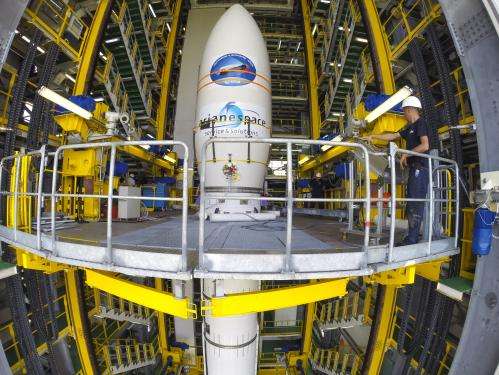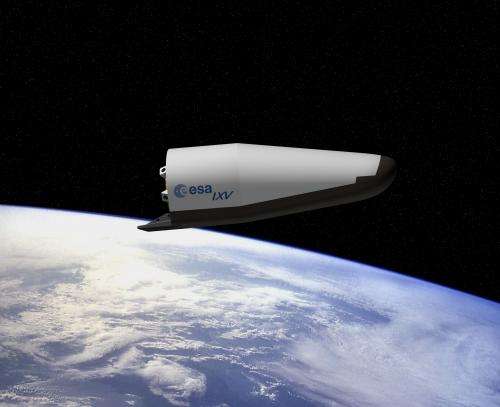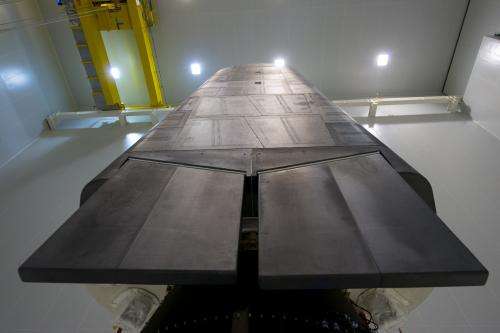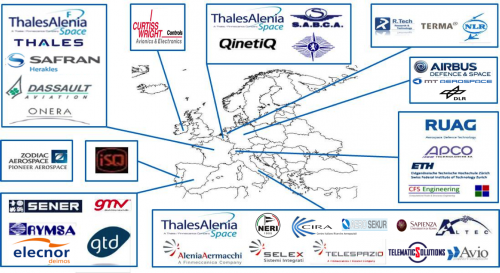ESA’s Vega VV04, carrying IXV, is fully assembled in its mobile gantry, at Europe's Spaceport in Kourou, French Guiana, on 30 January 2015. IXV will be launched 320 km into space on top of a Vega rocket, VV04, climbing up to 420 km before beginning a long glide back through the atmosphere. In the process, IXV will gather data on reentry conditions to help guide the design of future spaceplanes. Credit: ESA–M. Pedoussaut, 2015
ESA's experimental spaceplane, poised for liftoff on Vega, is set to showcase the latest technologies and critical systems to extend Europe's capability for space exploration.
In a world first, Europe will launch and land an unmanned spaceplane that has no wings but instead features an aerodynamic shape that produces the lift to fly through the atmosphere. Flaps and thrusters will autonomously steer it back to a splashdown at a precise point in the Pacific Ocean.
Most of our reentry knowledge comes from capsules and winged bodies developed in Russia and the US, and we have come a long way since ESA's first experiments with the conical Atmospheric Reentry Demonstrator, or ARD, flown in 1998.
Navigating reentry
When ESA's Intermediate eXperimental Vehicle, or IXV, descends into Earth's atmosphere it will be travelling at 7.5 km/s – typical of a mission from low orbit.
Friction with the atmosphere will slow the craft but if the angle of entry is too steep the craft will burn up. If the angle is too shallow, IXV cannot reach the required landing point.
As with all atmospheric entries, accurate guidance, navigation and control is everything. IXV must come in at the right angle and keep within a 'reentry corridor'.
IXV's sophisticated guidance, navigation and control system will use the body's lifting shape, two flaps and four thrusters to navigate through the atmosphere in a way to withstand the pressures and friction while heading to the landing point.
Artist impression of ESA's Intermediate eXperimental Vehicle (IXV) Credit: ESA - J. Huart
The thrusters and flaps will work together to change IXV's flight attitude – an important advance on ARD's thrusters only.
Protecting IXV
A new generation of large and advanced thermal protection panels will shield IXV from temperatures reaching around 1700ºC on reentry.
The black panels that cover the underside are made from high-performance carbon fibres woven into a ceramic matrix pattern for heat resistance and strength.
The IXV Intermediate eXperimental Vehicle installed on its payload adapter, on 26 January 2015 at Europe's Spaceport in Kourou, French Guiana. IXV will be launched 320 km into space on top of a Vega rocket, VV04, climbing up to 420 km before beginning a long glide back through the atmosphere. In the process, IXV will gather data on reentry conditions to help guide the design of future spaceplanes.
The flow of heat across these panels will be mapped for the first time, by an infrared camera and 300 sensors spanning the spacecraft from nose to flaps. The panels are much larger than the alternative glued tiles.
European collaboration
IXV collaboration. Credit: ESA
ESA's experimental vehicle will shape future technological development by offering a wealth of precious data that will boost reentry research around Europe. There are just some things that cannot be tested in the same way in laboratories.
IXV represents the industrial, technological and scientific expertise of a consortium of around 40 industries, research centres and universities, mainly in Italy, France, Spain, Switzerland, Belgium, Ireland and Portugal, with support coming from Germany and the Netherlands.
Provided by European Space Agency


























